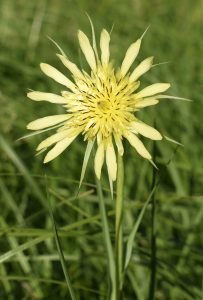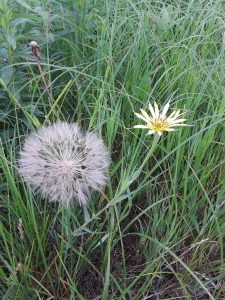Yellow Goat’s Beard
 For goat aficionados, here is the delightful yellow goat’s beard (Tragopogon dubius), also called yellow salsify. This is a non-native species found just about everywhere in Minnesota blooming late spring into summer. Look for a “herd of goats” along dry, open roadsides and in sunny meadows. The eye catching flowers jump out at you, and resemble a lovely exploding star of light yellow, up to 2″ across, with slender green bracts extending beyond the petals for a dramatic effect. Like the dandelion and sunflower, yellow goat’s beard is a ray flower in the Aster family. Like its cousin, meadow goat’s beard, yellow goat’s beard is edible and has also been traditionally used for its healing qualities.
For goat aficionados, here is the delightful yellow goat’s beard (Tragopogon dubius), also called yellow salsify. This is a non-native species found just about everywhere in Minnesota blooming late spring into summer. Look for a “herd of goats” along dry, open roadsides and in sunny meadows. The eye catching flowers jump out at you, and resemble a lovely exploding star of light yellow, up to 2″ across, with slender green bracts extending beyond the petals for a dramatic effect. Like the dandelion and sunflower, yellow goat’s beard is a ray flower in the Aster family. Like its cousin, meadow goat’s beard, yellow goat’s beard is edible and has also been traditionally used for its healing qualities.
Goat’s beard is a biennial plant with a small rosette of leaves the first year. The 2nd year, one or more 1 – 3 foot stems ascend from the remains of the rosette with alternating blade-like leaves that are up to 12″ (smaller as they get higher) strongly clasping the stem. At the tip of each stem is a long stalk with a single flowerhead. The leaves are long and narrow, sometimes folding lengthwise a bit. Like dandelions, the leaves and stems exude a milky latex when bruised. The foliage is very easy to miss because it closely resembles crab grass.
The flowers tend to face the sun, so if you are walking along a road some cloudless morning heading east, you may miss them altogether, only to find their sunny faces smiling at you upon your return — but that’s only if you hurry back ! Flowers close completely up by noon!
 Seed heads eventually form and dry into huge balls of whitish fluff, very similar to dandelions except for being a gigantic three inches in diameter.
Seed heads eventually form and dry into huge balls of whitish fluff, very similar to dandelions except for being a gigantic three inches in diameter.
